|
Volume XXXI - 2000
Why So Many Siskiyou Plants?
By John Roth
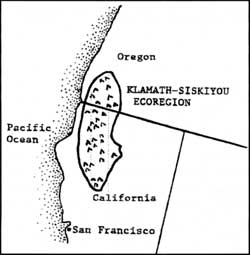
The Klamath-Siskiyou Ecoregion, hereafter KSE, is an oblong area that
extends from Roseburg in southwestern Oregon to the Yolla Bully range in
northwestern California. The varied geology, location, and microclimates
of the KSE accelerated plant evolution and migration but slowed
extinction. At least 3,000 types of plants and all the major forest
types in western North America occur here. More than 200 of these plants
are KSE endemics, the name for a species found only in a particular
area. Oregon Caves National Monument, as a small but important zone of
transition in the KSE, illustrates this floral diversity by boasting
almost one plant species per acre.1
Geologic controls
Ocean basins were spread apart or squeezed for more than half a
billion years while molten magma crystallized into rocks as different as
basalt and granite. Erosion and metamorphism created another range of
strata as well: sandstone, marble, pebbly conglomerate, glacial silt,
and "baked" muds. Faults uplifted and split rock masses apart, changing
what once were islands and ocean basins into a complex rock mosaic. This
fragmentation of habitat favors small populations on each type of soil
or rock, a situation in which mutations that give rise to new species
are not diluted out of existence by interbreeding with large
populations.
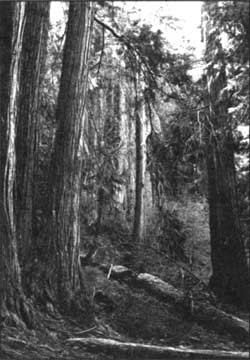
A stand of Port Orford-Cedar near Oregon
Caves.
|
Peridotites are rocks with potent quantities of minerals like iron
and magnesium that change to metal-rich serpentine when hot water is
added. Since most life is not adapted to metals normally found deep in
the earth, these metals disrupt photosynthesis and inhibit microbes. The
most toxic may be nickel, chromium, and cobalt though plant distribution
in the KSE seems to be governed by the occurrence of magnesium. Little
soil forms because clays need aluminum, an element lacking in
serpentine. This and the toxicity of metals in serpentine will not allow
clay, organics, or soil clumps to hold water, The cycle snowballs and
becomes a situation where thin soils are often dry, hot, and
nutrient-poor. This provides open habitat, increases population
turnover, and thus encourages the evolution of new species. Because
their populations are smaller, species that are rare usually evolve
faster than common and/or widespread plants. Of the 200 endemic plant
types in the KSE, 141 are either rare or uncommon, a very high ratio for
endemics.
The low productivity of serpentine soils limits the dispersal of
endemics to new areas because of fewer pollen grains, seeds, or tall
plants. Seeds in serpentine tend to be larger because of being in such
stressful habitat, so as to give seedlings a head start on life. This
characteristic may also limit dispersal, thus increasing the number of
endemics.
The most common response for most plants on serpentine is to keep
nickel out of their cells. Even some mariposa lillies and wild
buckwheats living on non-serpentine soils tolerate high amounts of
normally toxic metals, so they appear better prepared for evolving new
species on serpentine soils, Some KSE plants have found other ways to
avoid serpentine toxicity. In an endemic pennycress mustard and jewel
flower, the plant stores nickel within its cell tissue. Another jewel
flower (Streptanthus tortuosus) has developed a race of
serpentine-tolerant plants and so may be on its way to becoming a new
species.
Rapid evolution is also indicated by the fact that roughly two-thirds
of KSE endemics are varieties or subspecies that likely are on their way
to becoming full species. The crowding of habitats in the KSE results in
many hybrids, some of which have given rise to new species.
An avenue for plant migration
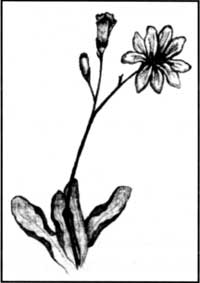
Imperial Lewisia. Drawing by Heather McDonald.
|
The KSE is unusual in that it has more serpentine than any other
ecoregion. The serpentine masses and size of the KSE helps plant
migrants find suitable habitats more easily but are big enough to keep
extinction rates low. Serpentine in the Illinois Valley, for example, is
fragmented and possesses different chemistries—an ideal situation
for rapidly evolving small populations. The effects of fire or other
disturbances may be so long lasting that plant populations are separated
sufficiently and can evolve into new species. By the same token,
disturbances in the KSE are not so large and competition among plants is
not intense enough for extinction rates to increase. Varied rainfall
amounts, frequent burns, and areas that serve as barriers (riparian
zones, serpentine, cliffs, north slopes) tend to limit fires to patches
of moderate size and intensity. Consequently, no one successional stage
dominates with its restricted number of species.
Another reason for the relatively high species diversity in the KSE
is because it contains the only mountains linking coastal ranges in
California and Oregon with the Cascade-Sierra cordillera. Plants more
easily cross over east-west oriented mountains, unlike north-south
ranges where plants must migrate along lines of longitude if they cannot
cross high elevations. Migration can promote speciation because it
produces numerous small and isolated populations near the range limit of
a species, a situation common in the KSE. Proximity to the endemic-rich
Cascades, Sierra, and the coast ranges of northern California has
increased plant diversity as the KSE shares over 200 endemics with these
physiographic regions. At least half of those plants probably originated
in the KSE.
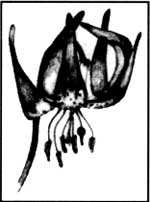
Vollmers Tiger Lilly. Drawing by Heather
McDonald.
|
Extinction is low among shrubs and trees generally, furnishing an
important reason why they comprise many of the paleoendemics, or "living
fossils." If you live a long time, you have more chance of reproducing
at least once successfully. Even serpentine herbs tend to be long-lived,
a trait indicative of harsh environments, and one the likely increases
the number of endemics. During the great climate changes over the last
few million years, the closely packed habitats of the KSE allowed plants
to grow in adjacent habitats that increased the chances for survival
when the climatic regimes shifted. Some habitats shrank considerably,
but paleoendemics in them continued to thrive. Port Orford-cedar and
Brewer (or weeping) spruce are examples of paleoendemics that once had
more extensive ranges.
Another type of endemic commonly found in the KSE is the edaphic
endemic or geoendemics—those species mostly restricted to one soil
type or topographic situation. Neoendemics (plants with no nearby
relatives) in the KSE also appear to be more common near the north end
of their range at high elevations, perhaps because they are also glacial
relicts that found suitable cool and open habitats to colonize. Among
the endemic plants in the KSE, 80 types are found only on serpentine,
while seven are confined to granite, four on marble, and three on
volcanic rock.
Other factors promoting diversity
A lack of nutrients and water (up to a point) encourage greater
diversity because plants then spend more of their energy surviving such
conditions rather than competing with other plants and causing them to
become extinct. The leaching of soil nutrients through high temperatures
and rainfall lowers the productivity of soils and may increase the
diversity of herb. Since the KSE is characterized by low rainfall during
the growing season for herbs, habitat diversity is heightened because
there are marked differences in slope and aspect that control
evapotranspiration and the water retention capacity of soils.
More nutrients and water allow certain plants to dominate and thus
reduce plant diversity, the so-called paradox of enrichment. The KSE is
an area of climatic extremes, with annual rainfall amounts ranging from
100 inches near the ocean to 15 inches further inland. The differences
in rainfall gives rise to a patchy distribution of plants, with the many
subspecies and varieties of certain plants indicate rapid
speciation—especially in their adaptation to dry soils of
serpentine, marble, and granite. For example, dwarf ocean spray, myrtle,
buckthorn, and tanoak stay small in stature even if grown in gardens
with lots of water. Drought adaptations in endemic plant species include
large tubers (as in lillies and toothworts), woodiness (as in pussytoes
and pincushion), and waxy, hairy or divided leaves. Storing carbon
dioxide at night so that water is not lost through leaf pores by day has
favored many endemic sedums and lewisias.
The varied habitats and climate change over thousands or millions of
years resulted in 50 or more disjunct species, plants whose brothers or
population centers are hundreds of miles distant. Mutations are favored
in such situations because of their small populations and the need for
new adaptations to survive in a less than ideal habitat. The KSE also
hosts at least 100 plant species at the edge of their range, where
speciation most likely occurs due to isolated populations undergoing
rapid change. Being at the right location between northern and southern
plant communities, the KSE is situated so as to have a high number of
disjunct species as well as plants at their geographic limit.
As a refuge for plants that once ranged from Japan to Georgia, the
KSE provides rare habitat in the western United States. Many of the
plant relicts are members of old families: heathers, orchids,
honeysuckles, birthworts, and lillies. Plants such as fairybells,
woodland stars, dogwoods, rhododendrons, redwoods, trilliums,
gaultheria, and coralroots have their greatest diversity of species in
the northwest and southeast United States, as well as in eastern Asia.
Paleoendemics evolved once tectonic forces and climate changes cut the
connections to other landmasses. Trees such as Port Orford-cedar and
Baker cypress, for example, have "twin" species in Asia. Likewise,
cousins of plants in the KSE such as vanilla leaf, tanoak, Oregon grape,
redwood, and skunk cabbage grow in eastern Asia.
Conclusion
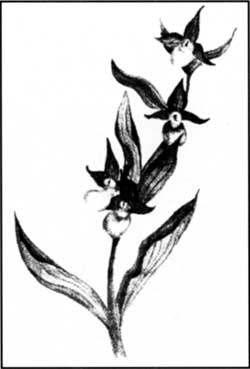
California Lady Slipper. Drawing by Heather
McDonald.
|
The KSE enjoys the best of diversity among plants; it contains older
flat areas where the lack of major disturbances has allowed
paleoendemics to survive, but also provides newer habitats like cliffs
and cirque lakes where new species can evolve due to isolation and a
lack of competition. Northern Florida may possess more paleoendemics and
Hawaii has greater numbers of neoendemics than the KSE. Parts of Nevada
and Arizona display more edaphic endemics, but the distinctiveness of
the KSE lies in its mix of all three types of endemic plants—more
profuse than anywhere north of Mexico. In few other places will the
location, size, varying ages and geodiversity of mountains with their
varied climates combine to produce so many relicts, disjuncts, endemics,
varieties, hybrids, and plants near their geographic limit. The Illinois
Valley is a botanist's delight each spring, while Oregon Caves
constitutes a representative slice of the fascinating floral diversity
found throughout the KSE.
Note
1The monument list contains some 400 plant species in only
480 acres, whereas Crater Lake National Park boasts fewer than 700 in
183,220 acres.
John Roth became fascinated with the plants of southwestern
Oregon upon arriving at Oregon Caves National Monument in 1988.
|

